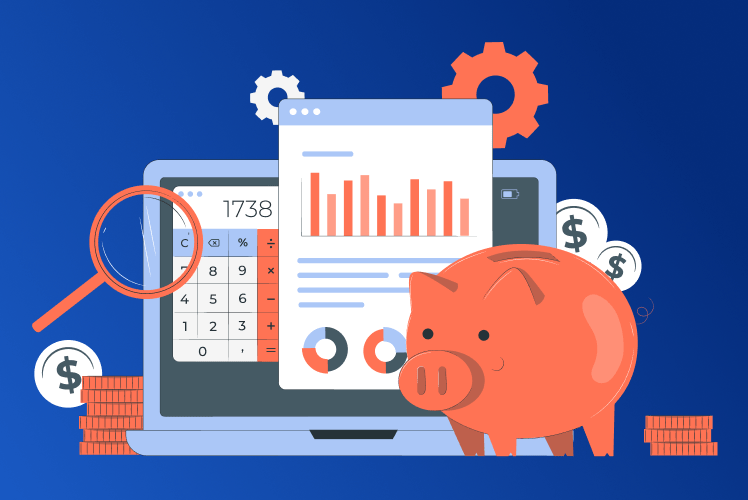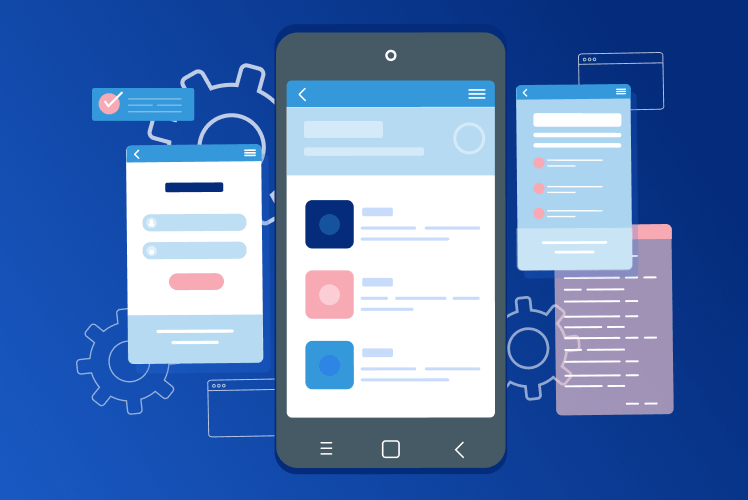Table of Contents
When it comes to creating new product (let’s say, software), its design plays a crucial role in attracting the users. However, it’s not enough to make the app attractive: it should also fulfill user needs and be user-centric and valuable. So who is the person responsible for that? In this article, we discuss the main differences (and similarities) between a product designer vs UX designer and the areas where their jobs overlap.

What is a UX designer?
Let’s start with the term that most people are familiar with and understand. A UX designer is a person who is responsible for creating and delivering user-centric and smooth user experience (UX). This person plans the entire interaction between a user and a product from the first contact to the last and uses relevant visuals and microcopy to evoke certain feelings and provide a seamless experience. For example, when you download a new app, the first thing that you see is a welcome screen – and it’s the job of a UX designer to create a feeling of enjoyment and anticipation by selecting the right visual elements.
As you might guess, UX is heavily based on psychology, user research, and business knowledge as well as technical skills. All these disciplines are needed to obtain a solid understanding of their target audience, their potential behavior, and what might attract and motivate them. In this way, every design choice is based on preliminary research and understanding of a user journey and user needs.
Key soft and hard skills needed for the role
A good UX designer needs to have a solid combination of certain soft and technical skills in order to successfully deliver one of a kind user experience.
The needed soft skills include:
- Empathy: important to “put oneself in someone else’s shoes” and truly understand the user and their potential needs/behavior/motivations;
- Communication: due to collaboration with various teams, it is vital to communicate thoughts and ideas effectively and listen to others;
- Analytical skills: the role implies performing both quantitative and qualitative research and using the collected data to make decisions.
As for the technical skills, they include a solid knowledge of relevant tools and software (i.e., Figma, Adobe XD, Balsamiq, etc.), an ability to create wireframes and prototypes, and an ability to create an information architecture. The requirements for the hard skills will depend on the project type.
Key responsibilities of a UX designer
Below, we listed the main responsibilities and explain why they are so important.
Competition analysis
A competitor analysis is an absolute must for creating any product. By learning about your competitors and about alternatives present in the market, you are able to:
- Learn what attracts users and what doesn’t work so well;
- Understand what unique features might help you stand out;
User research
User research is vital, as every element and every choice have to be user-centric. Hence, the first thing to do here would be to conduct a user research and create a buyer persona: a portrait of your perfect potential customer. This portrait usually includes not only demographic information but also information on a user’s online habits, hobbies, interests, motivations, etc. The buyer persona helps predict what might encourage users to interact with the product and what might be a turn-off.
Creation of user journeys and user flows
A UX designer is also responsible for creating user journeys and user flows. A user journey can be defined as a sequence of steps that a user takes to accomplish a high-level task: for example, to purchase the needed item online.
A user flow, on the other hand, is a sequence of steps needed to complete a certain task, i.e., log in the system. This process is much more granular than a user journey, and each user flow focuses on a single task.
A UX designer must understand how a user will interact with the product and what emotions they will experience at every step of the user journey. This understanding will help select the corresponding visual elements and display content in a way that a user will find intuitive and helpful.
Creation of wireframes and prototypes
One more important responsibility is the creation of wireframes and prototypes to present how the final product will look like and how all its components will be allocated. And since wireframes and prototypes are sometimes mistaken for each other, let’s quickly define what each term means.
A wireframe is a low-fidelity representation of a product. A wireframe typically displays its structure, main elements, and main text and graphic blocks. In wireframes, the text is commonly replaced with the Lorem ipsum placeholder and the images are displayed as simple boxes. But since the main goal of a wireframe is to show how the product will approximately look and what will belong where, such simplicity is perfectly fine.
As for prototypes, they can be defined as an evolution from wireframes. A prototype is usually a functioning, high-fidelity version of a final product that is used for user testing. Changes to the prototype can be made after receiving user feedback.
Work with developers
And obviously, a big part of this job is collaboration with other team members, mostly developers. UX designers have to make sure that proposed content functions as intended and aligns with the user interface. For that, UX designers need to collaborate closely with the team.
What is a product designer?
In a nutshell, a product designer is a problem solver. This person is responsible not only for the design but also for deciding how the product will fit in the market, what user needs it will solve, and what business needs it will help to achieve. In addition, this person is responsible for evaluating the product success after its launch and for any further iterations. As you can see, it’s quite a lot to deal with.
Key soft and hard skills needed for the role
Considering the complexity of the role, a list of needed soft and hard skills would vary depending on the hiring company. Below, we list the most common ones.
Soft skills include:
- Communication and collaboration: a product designer constantly communicates and collaborates with all stakeholders and hence, it’s critical to set up and maintain effective communication;
- Leadership: since a product designer is the one who comes up with the concept and justifies the decision, it is important that this person has good leadership skills and knows how to manage teams;
- Creativity: it takes a great deal of creativity to come up with something new and hence, this skill is highly requested;
- Problem-solving: a product designer should be able not only to identify problems but effectively solve them.
As for the technical skills, the list includes knowledge of the most relevant and needed tools, knowledge of relevant collaborative tools, and strong knowledge of the industry.
Key responsibilities of a product designer
Though we’ve briefly discussed the main responsibilities above, let’s pay a bit more attention to them, so you fully understand the role.
Research of users and their needs
A product designer creates a product from scratch and hence, has to understand both users and their needs/pain points to create a solution. A UX designer, on the other hand, works with a ready concept. But what’s similar in both roles is the need to know what motivates and triggers the target audience, and what solution would fulfill their needs.
Communication with stakeholders
Since a product designer is responsible for creating a product from start to finish and has to consider both business objectives and user needs, it’s natural that this person collaborates with all stakeholders. This person works closely with developers and marketers to ensure their vision is communicated clearly and that everyone stays on the same page.
Prototyping and wireframing
A product designer also creates wireframes and prototypes to show how the product should look and function. They can use various tools and methods to quickly craft wireframes and prototypes, especially low-fidelity ones. The use of such specialized tools greatly speeds up the prototyping process and allows faster testing of ideas, which sometimes can be crucial.
Testing and feedback collection
A product designer is responsible for ensuring that the product fully meets user needs and hence, another responsibility is post-launch testing and feedback collection. Working together with the team, a designer usually comes up with certain KPIs that help define the success of the product. So once the product is launched, a designer closely monitors its performance, measures it against set KPIs and determines what adjustments are needed.
As well, this role implies collecting feedback from users to learn whether the product satisfies them or whether anything should be added/changed. All this information is collected for use in another iteration.
Discussing the difference between product designer and UX designer
During the discussion of these two roles, you might have noticed that they overlap in certain areas: prototyping, user research, use of specialized tools, etc. Hence, it’s important to emphasize the core differences between the UX design vs product design to avoid any possible confusion.
Scope of work
A UX designer is responsible for user experience, from the first point of contact to the last one. To successfully deliver a smooth user experience, it is important to research target users and perform a competitor analysis to understand what will help the product stand out and to communicate the brand’s voice effectively.
A product designer is responsible for the overall success of the product. That means, the workflow starts with the research of the market, identification of opportunities, and evaluation of how the proposed solution will cover the current user needs. As well, a product designer closely monitors product performance, measures its success with the help of KPIs, and collects user feedback for future alterations.
Focus
When comparing a UX designer vs product designer, the first has a narrower focus, and here is why. In their work, a UX designer is responsible for the user experience part and does not have to calculate the product’s success or compare its performance against the competition. Most often, as soon as a UX designer finishes their part of work for a certain project, they switch to another one.
A product designer, on the other hand, has a much broader focus and has to consider not only the user experience but all aspects that define the project’s success. This person leads the process from start to finish and continues their work even after the launch.
Product development cycle
Another big difference between product designer and UX designer is the stage of the development life cycle that they work on. A UX designer normally joins the team after the concept is finalized and all preliminary research is performed. A product designer is present at early stages and participates actively in creating the product concept and performing all needed research.
Product designer vs UX designer: salary
It’s challenging to compare the salaries of these two roles, since the numbers will heavily depend on many factors: location, experience, seniority level, etc. However, we can provide approximate numbers that illustrate the salary levels across multiple countries in general.
UX designer:
- United States: $94,351
- United Kingdom: $65,956
- Canada: $61,998
- Europe: $47,809 – $56,967
Product designer:
- United States: $82,582
- United Kingdom: $50,000
- Canada: $45,000
- Europe: $58,757 – 70,333
Whom do you need for your project: product designer vs UX designer?
When it comes to UX vs product design, both roles are highly important. In order for a product to please users and bring tangible benefits to the business, it is important not only to make it appealing but also relevant and valuable. Hence, it’s impossible to choose between the product designer vs UX designer: both should work in conjunction and communicate effectively to bring the initial product vision to life.



Comments